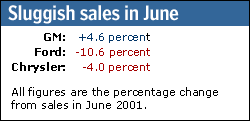
NEW YORK (CNN/Money) - Auto sales in the United States may have slumped a bit in June, but it might be too soon to start worrying that Americans' love for cars, one of the stronger aspects of the struggling U.S. economy, is going away.
Ford Motor Co. (F: Research, Estimates) and the Chrysler Group unit of DaimlerChrysler AG (DCX: Research, Estimates), the second- and third-biggest U.S. automakers, reported a drop in June U.S. auto sales Tuesday, while No. 1 automaker General Motors (GM: Research, Estimates) announced another round of aggressive sales incentives, even as it reported a slight gain in June sales.
Together, the news had some analysts worried about the future health of auto sales, which make up about 24 percent of all U.S. retail sales and about 4.45 percent of the $9.5 trillion U.S. gross domestic product, the broadest measure of the economy.
"While auto sales make up a small share of GDP, they make up a big share of the change in GDP," said Carl Tannenbaum, chief economist at LaSalle/ABN AMRO. "As you see changes in the auto industry, it will contribute to headline economic growth numbers."
While slower June auto sales could slow down GDP growth in the second quarter, Tannenbaum pointed out that the biggest, most expensive vehicles, such as SUVs, still have some of the strongest sales, a positive sign for the future of consumer spending, which makes up about two-thirds of GDP.

"Even with zero-percent financing, monthly payments for SUVs are still high," Tannenbaum said. "Consumers being willing to pay that much makes a positive statement about their sense of financial well-being."
And others pointed out that some pull-back in sales is natural, following two extremely good years -- 17.4 million units sold in 2000 and 17.1 million sold in 2001.
"This is something people should have expected," said Michael Lucky, an industry analyst and president of Lucky Consulting in Woodcliff Lake, N.J. "Sales aren't falling off a cliff. The sales pace is slowing down some. Obviously, the industry would like it not to, but there are good reasons it is slowing down."
For one thing, Lucky pointed out, a wave of home refinancing, which put cash in consumers' pockets and spurred some of last year's brisk auto sales, slowed down temporarily.
But refinancing activity has picked up again recently, driven by a continuing drop in mortgage rates, and that should fuel higher auto sales later in the year, Lucky said.
"We think the mid-16-million-unit range is achievable," Lucky said. "Sales will be down, but they'll still have a very solid year."
The pros and cons of incentives
Incentives such as zero-percent financing -- introduced by GM last fall and re-introduced a number of times since -- will also keep sales afloat, keeping plants open and workers busy, which is good news for the economy.
On the other hand, such aggressive incentives are bad for automakers' profits, which could cut into their desire to hire new workers and otherwise spend on improving production capacity. They might also have spoiled consumers, making them reluctant to buy a new car until they see a sweet deal.
"We've given the auto industry steroids, and we might be looking at a period of withdrawal as auto companies wean themselves from these stimulants," said Tannenbaum of LaSalle/ABN AMRO.
Still, as long as interest rates are low -- and the Federal Reserve has kept its target for a key short-term interest rate at a 40-year low all year, keeping the economy's accelerator floored -- then it doesn't cost as much for automakers to offer zero-percent financing. And such aggressive incentives can grow sales even to people who don't qualify for them.
"There are not so many people that can actually qualify for zero-percent financing," said Efraim Levy, industry analyst at Standard & Poor's. "But the incentives get them into the dealership, where they might get something else."
Mixed signals
When the Fed starts raising rates again, as it is expected to do sometime at the end of this year or early in 2003, then zero-percent financing could finally go away for good. But Levy, who expects auto sales of 16.5 million units this year and slightly better in 2003, said automakers will likely find other incentives to boost sales.
And brisk sales last year may have left inventories of autos and auto parts at low levels, encouraging more production.
| |
 Related links
Related links
| |
| | |
| | |
|
"All three of the Big Three automakers have been increasing the amount of their production planning," said LaSalle/ABN AMRO's Tannenbaum. "We're also seeing a little kick-up in overtime hours. Even if demand tapers off, they'll need to get production going to get inventories to more normal levels."
But Walter Huizenga, president of the American International Automobile Dealers Association in Alexandria, Va., said he has heard the exact opposite -- that inventories at dealerships are actually high.
Huizenga saw a more positive sign in the explosive 15.2-percent jump in U.S. sales by BMW, the high-end automaker. There are two types of buyers in the market, he said -- those looking for deals and those looking for specific types of cars and ignoring deals.
"It's not like what we would see in an ordinary downturn, where everybody would be motivated by deals," Huizenga said. "The auto business is as hard to explain as the rest of the economy."

|

